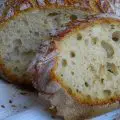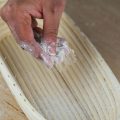There are many ways to fold and shape your dough in sourdough bread baking. If you’re familiar with the stretch and fold technique, then perhaps it’s time to take a look at a similar process. Here’s everything you need to know about coil fold sourdough making!
![What You Need To Know About Coil Fold Sourdough [Doing It Right!] 1 Coil fold sourdough](https://www.mydailysourdoughbread.com/wp-content/uploads/2022/08/sourdough-pizza-dough-scaled-720x480.jpg)
Table of Contents
- What Is A Coil Fold?
- How To Coil Fold Sourdough?
- Can You Over Fold Sourdough?
- Coil Fold vs Stretch And Fold
- When To Use Coil Folds vs Stretch & Folds
- Different Techniques of Sourdough Kneading
- Coil Fold Sourdough
- FAQs
What Is A Coil Fold?
A coil fold is a strengthening motion, commonly used in developing gluten during the bulk fermentation stage. Coil folds are similar to stretch and fold in the sense that they should be performed on the dough without removing it from its proofing container. Simply put, it is a method of folding dough that relies on both surface tension and gravity.
Why Use A Coil Fold?
Coil folding is an incredible method to go for, especially if you’re working with high-hydration doughs, or need some help with gluten development. The coil and fold method also ensures a precise fermentation rate, complete with a consistent crumb structure.
Since the coil method utilizes surface tension, it is easier to pinpoint the gradual development of your dough, than if you were to use a stretch and fold method. It’s also an extremely gentle way of handling your dough, as well as helping it develop the strength it requires for the oven.
How To Coil Fold Sourdough?
Before you get to coil folding your sourdough, beware that coil folds work best with higher hydration doughs.
Here’s how to perform a coil fold:
- Gently ease the edges of the dough, by pulling them away from the sides of the bowl.
- Place the tips of your fingers beneath the dough, so that you can easily lift it in the middle.
- Let the dough fall, while your fingers remain supporting the center of the dough.
- Rotate the bowl 90 degrees and repeat so that you perform 2 coil folds per set.
How To Stretch And Fold Sourdough
The process of stretching and folding dough is another great technique used to develop gluten strands in the dough. It is perhaps one of the most common techniques used among sourdough bakers and can be done in a bowl, or countertop.
Here’s how to stretch and fold sourdough:
- First, you must decide whether you wish to perform your stretch and folds in a bowl, or atop the kitchen counter. If you’re planning to do them on the counter, then gently flip the dough out so that the less sticky side is on the bottom.
- Wet your hands slightly, so that it’s easier to handle the dough.
- Gently work your way around the dough, ensuring that you are paying attention to every crevice.
- Pull the dough up and over to the other side of the bowl.
- Stretch and fold each part of the dough, until you have performed this 4 times.
- You will feel the dough strengthening as the gluten tightens.
Can You Over Fold Sourdough?
Yes, you can easily overfold sourdough. The folding technique you go for should provide sufficient dough strength.
Once the gluten network has formed, over-folding the dough can cause it to break down.
You must ensure that you aren’t over-handling the dough. Each set of stretches and folds should consist of no more than 4 stretches and folds.
Coil Fold vs Stretch And Fold
Both folding techniques are great to use in a basic sourdough recipe. However, coil folds are a gentler form of dough strengthening without the more aggressive handling from the stretch and folding.
The stretch and fold technique is best used for medium to low-hydrated doughs, while coil folds are often used in higher-hydration doughs for a more open crumb.
When To Use Coil Folds vs Stretch & Folds
Now that you understand a bit about coil folds, let’s take a look at when you would use them:
Stretch & Folds
- Stretch and folds typically work with most dough types, ranging from low to high hydration.
- You can use them to add additional flavors and other ingredients to your dough.
- It can be difficult to stretch and fold wet and sticky dough.
Coil Folds
- Coil folds work best with higher hydration dough.
- You can’t use the coil fold technique to add flavors and other ingredients.
- You can build enough dough strength with wet and sticky dough.
![What You Need To Know About Coil Fold Sourdough [Doing It Right!] 2 What you need to know about coil fold sourdough [doing it right! ]](https://www.mydailysourdoughbread.com/wp-content/uploads/2023/01/blog-images-29-720x405.jpg)
Different Techniques of Sourdough Kneading
The way you handle your dough will heavily impact the gluten development, and dough structure, as well as dictate how effectively your dough retains its gas bubbles while baking.
Here are some of the basic ways to handle your dough:
Mixing & Kneading
Both mixing and kneading are types of aggressive dough handling. By combining the ingredients in the beginning, you’re working towards strengthening those gluten strands in your dough. For your sourdough recipes, you may need to combine flour, water, salt, and a sourdough starter. The kneading manipulates the dough to encourage gluten strengthening and development.
Hand Kneading
Hand kneading is quite possibly the most straightforward technique. It requires pushing the dough on the counter using the heel of your hand. You can even rotate the dough slightly with each push, to maintain a dough circular shape. The rotation helps to evenly distribute dough tension and encourages a constant kneading rhythm.
Though popular, hand kneading requires sweat and grit. After a couple of rounds, you’ll feel your arms and hands aching from the aggressive exercise. The more force you apply towards the dough, the faster the dough comes together and the quicker the gluten strands develop.
Hand kneading works best with low-hydration dough, especially those that won’t stick to the counter with every push and shove.
Rubaud Mixing
Rubaud mixing is a form of hand mixing and kneading invented by Gerard Rubaud. This technique involves taking your cupped hands to continually scoop the dough up from the bottom, stretch it and gently let the dough fall back on itself. This technique can be done in a bowl and is probably a cleaner way of handling the dough, as minimal contact with the dough means less dough on your hands.
This type of mixing works best for high-hydration doughs.
Mechanical Mixing
While hand kneading is quite the workout, some of us sourdough bakers may require a little assistance with this tedious task. Stand mixers and bread machines are a baker’s best friend. Your dough can go from mixing to full gluten development in under 10 minutes, and at the push of a button!
Folding
Folding involves stretching and folding the dough over itself throughout the bulk fermentation stage. Though laborious, it is also extremely important for sourdough bread. It distributes the gases and microbes in the dough, regulates the temperature of the dough, and develops strength in the dough by generating physical tension.
Lamination
Lamination involves stretching the dough on a flat surface until it looks like a thin sheet of dough. The dough is then folded multiple times over itself and creates many visible layers of dough. Furthermore, it enables gluten development through aggressive stretching.
It’s best to laminate the dough during the early bulk proofing stage, as a method of speeding the gluten-developing process. This technique is best for high-hydration doughs, as they can stretch easily, whilst low-hydration doughs are a tad too stiff for this technique.
Is Coil Folding Better Than Lamination?
Lamination is the process of stretching the dough as thin as you can without tearing it. When the dough is stretched out entirely, it is then folded up into layers until it looks like a neat parcel.
When it comes to developing the gluten in sourdough bread, there isn’t much comparison between coil folding and lamination.
Coil folds can be performed simultaneously with lamination, to help develop a strong gluten network.
If you wish to incorporate flavors into your sourdough, you could easily perform 1 to 2 coil folds and then lamination towards the end of bulk fermentation for additional flavors.
![What You Need To Know About Coil Fold Sourdough [Doing It Right!] 3 What you need to know about coil fold sourdough [doing it right! ]](https://www.mydailysourdoughbread.com/wp-content/uploads/2023/01/blog-images-28-720x405.jpg)
Coil Fold Sourdough
Mastering the art of sourdough baking doesn’t come easily. But with simple yet informative guides, you’ll find yourself getting the hang of bread baking in no time!
Sourdough recipes to try today:
FAQs
What Is A Coil Fold In Sourdough?
A coil fold is a type of strengthening motion used to develop the gluten in the dough during bulk fermentation.
How Many Times Should You Coil Fold Sourdough?
Generally, 4 to 6 coil folds should be enough to develop the gluten for high-hydration dough.
Should You Slap And Fold Sourdough?
This will depend on the type of dough. Essentially, the slap-and-fold method works best with soft, medium-hydration doughs.






